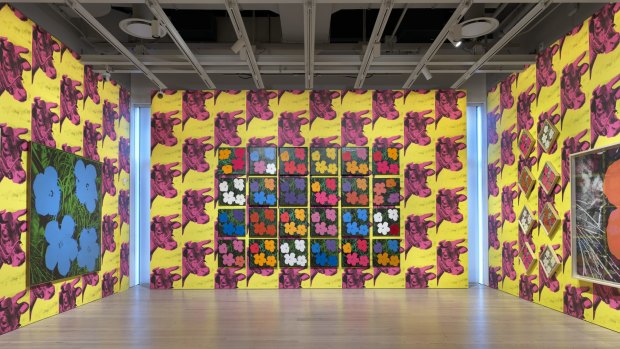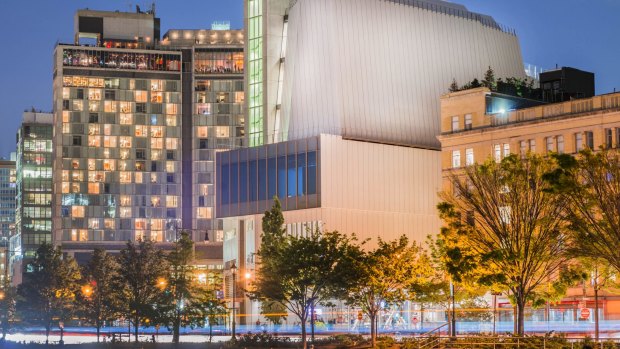This was published 5 years ago
Andy Warhol exhibition, New York: Andy Warhol exhibition at Whitney Museum of American Art
By Steve Meacham

From A to B and Back Again.Credit: Whitney Museum of American Art
Andy Warhol died more than 30 years ago yet remains one of America's most celebrated artists. He habitually carried a Polaroid or a movie camera around with him, along with a microphone, anticipating our modern obsession with Facebook and the selfie.
Warhol blurred the lines between celebrity (his screen prints of Marilyn Monroe, Elvis Presley and Marlon Brando) and the commonplace (images of Campbell soup cans and Brillo pads) and his most famous maxim – "in the future, everyone will be famous for 15 minutes" – seems a prescient warning about the kind of reality TV heroes and heroines we watch for a season, then spit out.
So there's huge interest in the Whitney Museum of American Art's current exhibition Andy Warhol – From A to B and Back Again. It is the most extensive review of his enormous contribution to popular culture in his adopted city since he died, with about 350 of his drawings, paintings, screen prints and movies on display. The New York Times has described the show as "brilliant".

The Whitney Museum of American Art.Credit: Whitney Museum of American Art
Unless you have plans to visit the Big Apple you may miss the exhibition at the Whitney but that's no reason why you should miss what the museum – founded and named after another Manhattan socialite every bit as complex and critical to the development of American art as Warhol: Gertrude Vanderbilt Whitney – has to offer.
The pair were complete opposites. Warhol was born in 1928 and grew up in industrial Pittsburgh, the bright, gay son of an impoverished immigrant woman who spoke little English and sold paper flowers after Warhol's father died in 1942. Gertrude, by contrast, was born into what was once America's wealthiest family, the Vanderbilt. She then married into the equally wealthy Whitney family.
What Warhol and Whitney shared was a belief in American art. And on this wet Saturday morning, as the queue wraps around what is now one of the main attractions of the fashionable Meatpacking District, they both might have appreciated the irony. In 1900, this part of lower west Manhattan was home to 250 slaughterhouses and meatpacking plants. (One of the last is still visible from the Whitney's elevated sculpture garden.
During Warhol's heyday, from the '50s to the '80s, this became a centre for clubs open to different types of sexuality – mainly gay and transsexual – fuelled by drugs and controlled by the mafia. Like other red light districts around the world, sleaze protected historic low-rise, low-rent buildings from crass high-rise '80s-style redevelopment.
Today, much of the Meatpacking District is heritage-listed and its buildings populated by fashion houses (Diane von Furstenberg was the pioneer), technology giants (Apple is a neighbour), nightclubs and restaurants.
The Whitney is at the heart of this urban rejuvenation. Designed by Renzo Piano, with views over the Hudson river, the $US422 million museum opened on its new site in 2015. And though lesser known than the Guggenheim, or MOMA, the Whitney is a cultural highlight worth adding to your agenda – with or without Warhol.
Whitney founded her gallery out of frustration. A talented Paris-trained sculptor, who was important enough for Rodin to critique her work, she sought to donate her entire collection of American art to the city's Metropolitan Museum of Art. When the trustees rejected her offer because it was uninterested in American art, she founded her own museum. Opened in 1931, its original home was in one of her art studios and was located – fittingly – in the Meatpacking District.
Among the 23,000 works by more than 3000 artists in the present collection, you'll see names you recognise, such as Roy Lichtenstein and Alexander Calder, and many more you've never heard of (at least I hadn't). Tip: take one of the free guided public tours because that way you'll stop and assess works you might otherwise only give a cursory glance. For example, Jasper John's 1958 work Three Flags which reassessed the Stars and Stripes during the Cold War period.
The most haunting work in the permanent collection is Alice Neel's 1970 portrait of Warhol himself. Devoid of his silver wig, his sunglasses and his audience, Warhol is revealed as the vulnerable human he was. Man boobs, pasty-skinned and scarred, he's wearing the surgical corset that preserved his celebrity after he was shot in 1968 by Valerie Solanas, a disgruntled author who believed Warhol had stolen a manuscript.
TRIP NOTES
Steve Meacham travelled courtesy of Singapore Airlines and NYC & Co.
MORE
FLY
Singapore Airlines flies from Singapore to Newark Liberty International three times a week. See singaporeair.com
VISIT
Andy Warhol – From A to B and Back Again is at Whitney Museum of American Art until March 31. To celebrate the final month of the show, during March the museum will open seven days a week. See whitney.org.
EAT
The museum's restaurant Untitled has views of the Hudson and the High Line. The Meatpacking District is a foodie's nirvana.
Sign up for the Traveller Deals newsletter
Get exclusive travel deals delivered straight to your inbox. Sign up now.